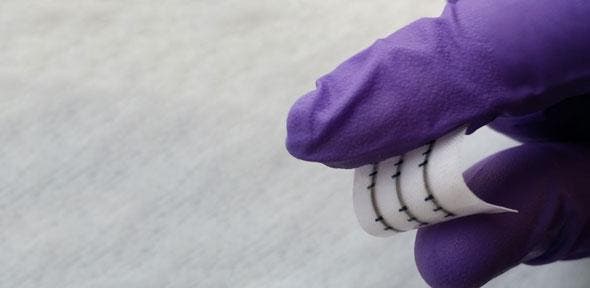With the growing use of wearables, tech-equipped fabrics have emerged as a versatile means of gathering data and interacting with an increasingly connected world. However, seamlessly integrating technology into fabrics can be challenging. Where previous tech-based fabric have come with limitations in form, function, and comfort, these two recent developments show promise for many different applications.  Image Source: Design News Magnetized Fabric With Encoded Info Researchers at the University of Washington have created a new type of smart fabric that’s able to store and transmit data without the use of conventional electronics. Instead, their fabric utilizes magnetized threads, in combination with a magnetometer, to encode, send, and store digital information, which can then be used for a range of different functions. The developers have specified the incorporation of built-in security and RFID tags as possible uses for the technology. Unlike previously developed smart fabrics, this latest prototype allows for a more natural incorporation and feel when it comes to the structure of a garment or accessory. Data, including serial numbers and 2D images can be encoded into the fabric of a tie, belt, wristband, or shirt cuff, which, upon being scanned, can trigger all manner of responses, from opening doors and triggering alarms, to accessing certain applications and software files.
Image Source: Design News Magnetized Fabric With Encoded Info Researchers at the University of Washington have created a new type of smart fabric that’s able to store and transmit data without the use of conventional electronics. Instead, their fabric utilizes magnetized threads, in combination with a magnetometer, to encode, send, and store digital information, which can then be used for a range of different functions. The developers have specified the incorporation of built-in security and RFID tags as possible uses for the technology. Unlike previously developed smart fabrics, this latest prototype allows for a more natural incorporation and feel when it comes to the structure of a garment or accessory. Data, including serial numbers and 2D images can be encoded into the fabric of a tie, belt, wristband, or shirt cuff, which, upon being scanned, can trigger all manner of responses, from opening doors and triggering alarms, to accessing certain applications and software files.  Image Source: ZME Science Printable, Electronic Fabric Ink Another smart fabric development comes from a collaboration between researchers from Britain, China, and Italy. Through the creation of graphene-based ink, they were able to incorporate electric circuits by printing them onto polyester fabric. Like the prototypes from the University of Washington, the digital ink allows for the creation of wearable electronics that feel like familiar articles of clothing and accessories, and also permit a limited number of washes and reduced power requirements. Production of the ink is also relatively inexpensive, safe, and more environmentally friendly compared to smart fabrics that requires the use of toxic solvents, which are sometimes required for electrical components that can be used within textiles. [embedyt] https://www.youtube.com/watch?v=OqimqTf6EP8[/embedyt] What are your thoughts on these developments? Will our next means of connection to the Internet of Things be through our clothing? Comment tell us what you think. Articles Sources https://www.designnews.com https://www.zmescience.com
Image Source: ZME Science Printable, Electronic Fabric Ink Another smart fabric development comes from a collaboration between researchers from Britain, China, and Italy. Through the creation of graphene-based ink, they were able to incorporate electric circuits by printing them onto polyester fabric. Like the prototypes from the University of Washington, the digital ink allows for the creation of wearable electronics that feel like familiar articles of clothing and accessories, and also permit a limited number of washes and reduced power requirements. Production of the ink is also relatively inexpensive, safe, and more environmentally friendly compared to smart fabrics that requires the use of toxic solvents, which are sometimes required for electrical components that can be used within textiles. [embedyt] https://www.youtube.com/watch?v=OqimqTf6EP8[/embedyt] What are your thoughts on these developments? Will our next means of connection to the Internet of Things be through our clothing? Comment tell us what you think. Articles Sources https://www.designnews.com https://www.zmescience.com
The following blog post Connectable Fabric Gets A More Natural Feel Read more on: http://magoda.com
No comments:
Post a Comment